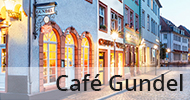Heidelberg Castle was the residence of the princes of the Electoral Palatinate until it was destroyed during the War of the Palatine Succession in the 17th century. One of those electoral princes was Frederick V, who married Elizabeth Stuart, the daughter of the King of England – it was a marriage based on true love.
Their time together as a loving couple had a dark side and a bright side. On the dark side, there was the Queen, who was originally opposed to the couple getting married due to the fact that Frederick was just an electoral prince and not a king.
On the bright side, there was the pure affection the two felt for each other, independent of any class conceit. In addition, they both appealed to their people because of their outward appearance. Elizabeth Stuart, for example, was also called the Pearl of Britannia as the way she looked matched the ideal beauty conception of those days.
They were the fairy-tale couple of their times. Frederick did not refrain from any cost or pain to please his wife. He organized costly festivities and even had the famous Elizabeth Gate built for her at Heidelberg Castle.
Many years later, when the electoral princes had long left Heidelberg Castle and it had become a ruin and was plundered, some people began to show interest in the castle in ca. 1820 and fought to recall its flourishing past. In particular, an exceptional task developed to ensure that the history of Heidelberg and its castle could live on.
Master baker Gundel, who ran Café Gundel, a focal point for Heidelberg society with a bakery and cake shop, at the foot of Heidelberg Castle, was given the task to create a speciality using his delicious ingredients to remind us of this loving couple from Heidelberg Castle and its good and bad times. On festive occasions, this was then to be served as a symbol of Heidelberg’s history.
His famous homemade nougat cream, which was known far beyond Heidelberg’s city limits and which all the inhabitants of Heidelberg loved so much, had to be part of it. But how should he use it to create a specialty commemorating the Royal Winter Couple? He still had to think of a great idea. The first of such festivities was to be celebrated in three days. The master baker was thinking and thinking as time was running out.
Nougat biscuits? No, it was not Christmas. A sponge cake? Boring. Marzipan nougat? Not fluffy enough. Nougat gateaux? No, it was not a wedding. Fine dark chocolate? …. Suddenly, he was interrupted in his thoughts: “Grandfather” somebody called from upstairs, “could you come upstairs, please?” His granddaughter Barbara asked him to read to her the story of the Frog Prince because she could not sleep. So, he told her the story, and listening to the calming words of her grandfather, the little girl slowly fell asleep.
The story of the Frog Prince was running through the master baker’s head and inspired him to create his specialty from his excellent chocolate and other ingredients in the shape of a ball. Thus, an idea was born. The idea of a metamorphosis, of creating something unexpectedly wonderful from something simple.
A combination touching all spirits: A fine sponge dough ball with a core-filling of his legendary nougat cream covered by delicious marzipan and chocolate. An appropriate name was easily found. It was supposed to carry the name of the one it was meant for, i.e. Heidelberg Kurfürstenkugel.
In honour of the electoral prince’s wife, master baker Gundel not only created a dark Kurfürstenkugel, but also a white one covered with fine white chocolate reminding us of Elizabeth Stuart as the Pearl of Britannia.
How was it supposed to be wrapped? Always two of them together: a dark and a white Kurfürstenkugel to commemorate the dissimilar, but inseparable loving couple.
To keep the memory of the idea’s origin alive, he later asked a befriended painter to paint the Frog Prince in an appropriate electoral prince’s robe to decorate the chocolate box with.
From then on he offered the Kurfürstenkugel to all Heidelberg inhabitants and visitors to the city. He managed to create a symbol for Heidelberg, uniting Gundel’s specialties with the history of Heidelberg and its castle. Sitting in Café Gundel in Heidelberg today, which is run by Christian Gundel in the fourth family generation, one can comfortably enjoy the Kurfürstenkugel while looking at the castle and thinking of the story of the loving couple.
* For those interested in Heidelberg’s history, this is how things continued .. ...
The Prince Elector Fredrick V planned and built an immense pleasure garden at Heidelberg Castle when he was only a 17-year-old. People at that time regarded the huge movement of earth that was necessary for this as the 8th Wonder of the World.
The attempt to turn the Electoral Palatinate into a Protestant supremacy in the Holy Roman Empire under the rule of Frederick V ended in a big defeat.
In 1619, Fredrick V accepted his election as King of Bohemia, although many advisers had explicitly warned him against doing so. He was not able to keep the crown as he lost, among others, the Battle of White Mountain. His kingdom only survived just over one winter and that is why the couple were called the Winter King and the Winter Queen.
After the Thirty Years War entered a further phase, Fredrick V became a political refugee. After the adventures in Bohemia, Elizabeth was also no longer given political support by her father in England. They could not return to Heidelberg either. Everyone had enough to do in rebuilding the country after the war.
Elizabeth went into exile together with her husband and shared his fate as a refugee until his death in 1632.







